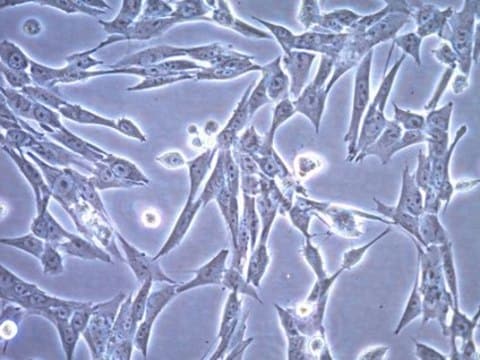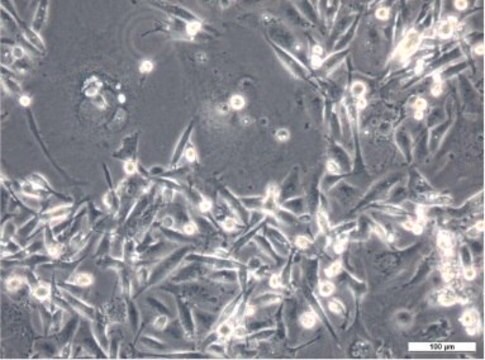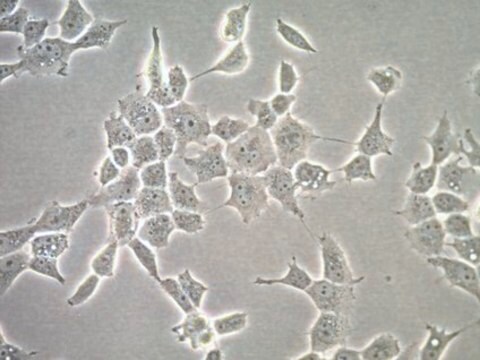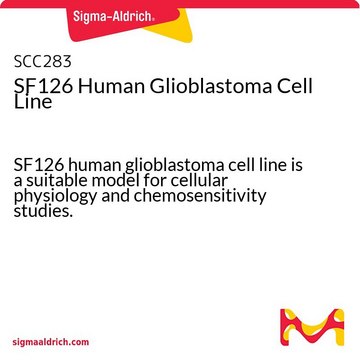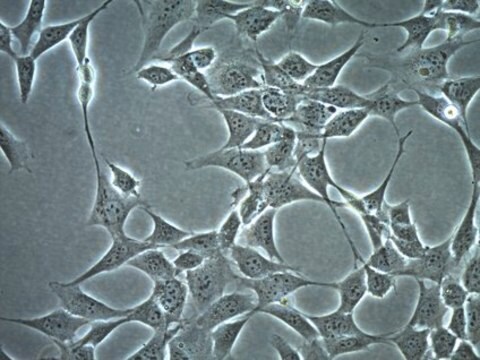08061901
U-373 MG (Uppsala) cell line
Synonyme(s) :
U-373MG Cells, U373-MG Cells, U373MG Cells
About This Item
Produits recommandés
Source biologique
human brain
Niveau de qualité
Forme
liquid
Mode de croissance
Adherent
Caryotype
2n = 46
Morphologie
Pleomorphic/astrocytoid
Récepteurs
PDGFR alpha and EGFR. See Nistér M. et al., (1988) & (1991)
Technique(s)
cell culture | mammalian: suitable
Maladie(s) pertinente(s)
cancer
Conditions d'expédition
dry ice
Température de stockage
−196°C
Origine de la lignée cellulaire
Description de la lignée cellulaire
Background to the identity query for the cell line U-373 MG: The American Type Culture Collection (ATCC) reported that their stock of U-373 MG had been shown to have differing genetic properties to stock from the originator′s laboratory, and to share similarities with another glioblastoma cell line, U-251. In light of this, ECACC undertook an investigation into the authenticity of its own stock of the U-373 MG cell line. ECACC found similar results to the ATCC i.e. the stock held as U-373 MG was found to be identical by STR-PCR profiling to U-251. The U-373 MG cell line listed under catalogue number 89081403 has been re-named as ′U-251 (formerly known as U-373 MG)′.
Application
Actions biochimiques/physiologiques
Profil d'ADN
CSF1PO: 11,12
D13S317: 8
D16S539: 12,13
D5S818: 12
D7S820: 8.2,12
THO1: 7,9.3
TPOX: 8
vWA: 17,18
Milieu de culture
Procédure de repiquage
Autres remarques
Cultures from HPA Culture Collections and supplied by Sigma are for research purposes only. Enquiries regarding the commercial use of a cell line are referred to the depositor of the cell line. Some cell lines have additional special release conditions such as the requirement for a material transfer agreement to be completed by the potential recipient prior to the supply of the cell line. Please view the Terms & Conditions of Supply for more information.
Clause de non-responsabilité
Code de la classe de stockage
10 - Combustible liquids
Classe de danger pour l'eau (WGK)
WGK 3
Point d'éclair (°F)
Not applicable
Point d'éclair (°C)
Not applicable
Faites votre choix parmi les versions les plus récentes :
Certificats d'analyse (COA)
Désolés, nous n'avons pas de COA pour ce produit disponible en ligne pour le moment.
Si vous avez besoin d'assistance, veuillez contacter Service Clients
Déjà en possession de ce produit ?
Retrouvez la documentation relative aux produits que vous avez récemment achetés dans la Bibliothèque de documents.
Notre équipe de scientifiques dispose d'une expérience dans tous les secteurs de la recherche, notamment en sciences de la vie, science des matériaux, synthèse chimique, chromatographie, analyse et dans de nombreux autres domaines..
Contacter notre Service technique
